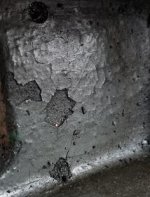Yan Wo
Stainless
- Joined
- Jan 22, 2014
- Location
- Highland, Utah, USA
My 1948 9A's bed appears to have been japanned.
If not, I wonder what the thick coating -- missing in spots -- is.
Years ago at <http://www.lathes.co.uk/southbend9-inch/>, I found a great history of the 9 inch lathe. It contains this interesting note:
My lathe is apparently one of those with the odd-ball bed, based on the "South Bend" cast into two of the cross-ribs.
If not, I wonder what the thick coating -- missing in spots -- is.
Years ago at <http://www.lathes.co.uk/southbend9-inch/>, I found a great history of the 9 inch lathe. It contains this interesting note:
Oddly, during 1947 (at a time that seems to have coincided with a new number system in march of that year) , a batch of lathes was produced that might be described as an "interim" model with longer, convex-ended feet and a bed that must have been from a new mould. This bed, which was used for a short production run only, lacked the pronounced rib along the lower edges, had a "square" profile in cross section (in comparison to the original round style) and (most distinctive of all) the word South Bed cast into the top face of two bed cross-ribs. After this the later style feet were adopted and the bed revered to the older style.
My lathe is apparently one of those with the odd-ball bed, based on the "South Bend" cast into two of the cross-ribs.



